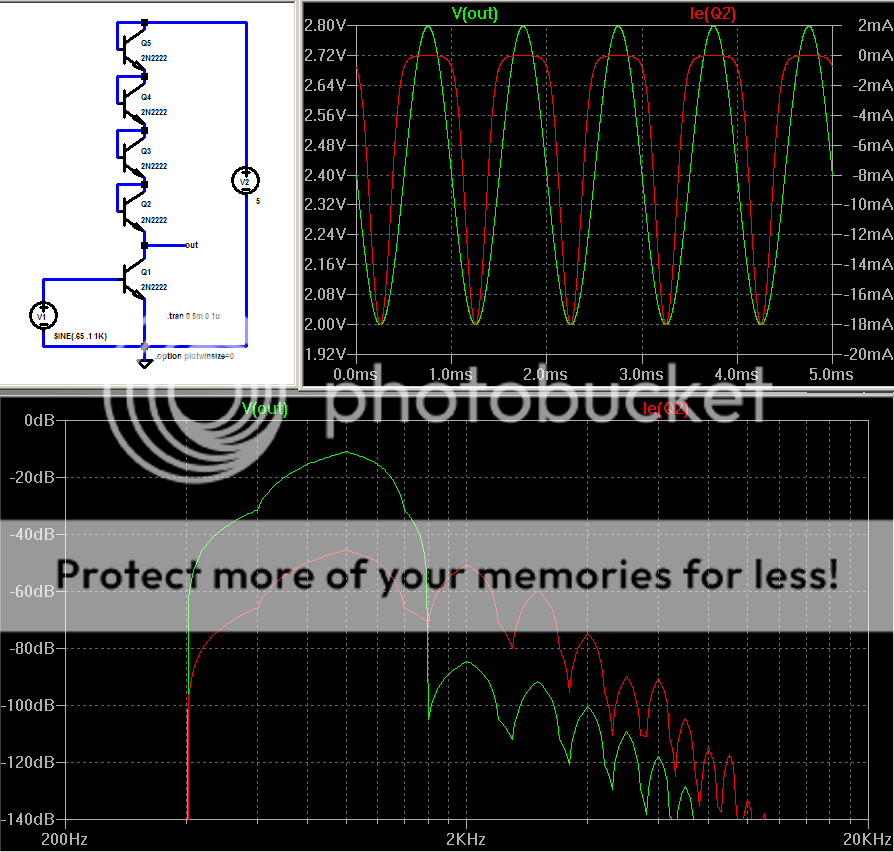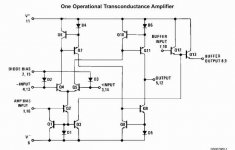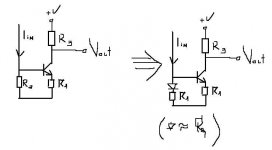Greetings.
Are linearizing diodes ever used to linearize the transfer characteristic of transistors in audio amps? I haven't seen any examples in the schematics. Google indicates that the technique is used in RF amps and diode lasers, but no examples in audio amps that I can find. Is there any role for them? what are the difficulties in using the technique? Are there any casualties among you from attempts to make it work? I look forward to your views with interest.
Are linearizing diodes ever used to linearize the transfer characteristic of transistors in audio amps? I haven't seen any examples in the schematics. Google indicates that the technique is used in RF amps and diode lasers, but no examples in audio amps that I can find. Is there any role for them? what are the difficulties in using the technique? Are there any casualties among you from attempts to make it work? I look forward to your views with interest.
Where to put diode in the transistor? You got example drawing?Are linearizing diodes ever used to linearize the transfer characteristic of transistors in audio amps
Take a look at this:
http://ca.search.yahoo.com/search?p...vl=&fl=1&vl=&pstart=1&fr=FP-tab-web-t912&b=11
Go to number 12.
http://ca.search.yahoo.com/search?p...vl=&fl=1&vl=&pstart=1&fr=FP-tab-web-t912&b=11
Go to number 12.
>Where to put diode in the transistor? You got example drawing?
I haven't sketched any examples yet. I will study the examples referenced in the reply from member lumanauw before spending time on it. I am putting off working on this idea in case there are some compelling reasons to avoid it.
I haven't sketched any examples yet. I will study the examples referenced in the reply from member lumanauw before spending time on it. I am putting off working on this idea in case there are some compelling reasons to avoid it.
>Take a look at this:
>http://ca.search.yahoo.com/search?p...b-web-t912&b=11
>Go to number 12.
There is plenty of material to study there. I am still curious why there are no examples of discrete amps using linearizing diodes.
I expect it is easier use them in ICs due to better matching of diode and transistor properties when they are on the same die.
>http://ca.search.yahoo.com/search?p...b-web-t912&b=11
>Go to number 12.
There is plenty of material to study there. I am still curious why there are no examples of discrete amps using linearizing diodes.
I expect it is easier use them in ICs due to better matching of diode and transistor properties when they are on the same die.
>Where to put diode in the transistor? You got example drawing?
I expect I would use them to linearize the input transistors which give voltage gain. Small signal transistors; FETs and tubes all seem to have a non linear transfer characteristic and so there might be a role for linearizing diodes. This would be an alternative to high open loop gain with feedback to achieve linearity.
I expect I would use them to linearize the input transistors which give voltage gain. Small signal transistors; FETs and tubes all seem to have a non linear transfer characteristic and so there might be a role for linearizing diodes. This would be an alternative to high open loop gain with feedback to achieve linearity.
The first think that comes to my mind is the baxendall diode as used inthe Linsey Hood 75 watt design ! This is used to match the transfer characteristics between the quasi-complimentary output stage transistors !
A similar technique is also used in the old Phase linear 400/700 power amps
Regards Trev
A similar technique is also used in the old Phase linear 400/700 power amps
Regards Trev

gain of 4
note I(Q2) nonlinearity
nonlinear diode connected transistor load increases singnal to distortion
58% THD Ie(Q2) - what you would get with a linear Resistor load
vs 0.023% THD V(out)
looks good, but not too practical - the output impedance also swings over a large nonlinear range - even a 10K load causes V(out) THD to jump up 8%
- Status
- This old topic is closed. If you want to reopen this topic, contact a moderator using the "Report Post" button.
- Home
- Amplifiers
- Solid State
- Linearizing diodes in amp circuits.

